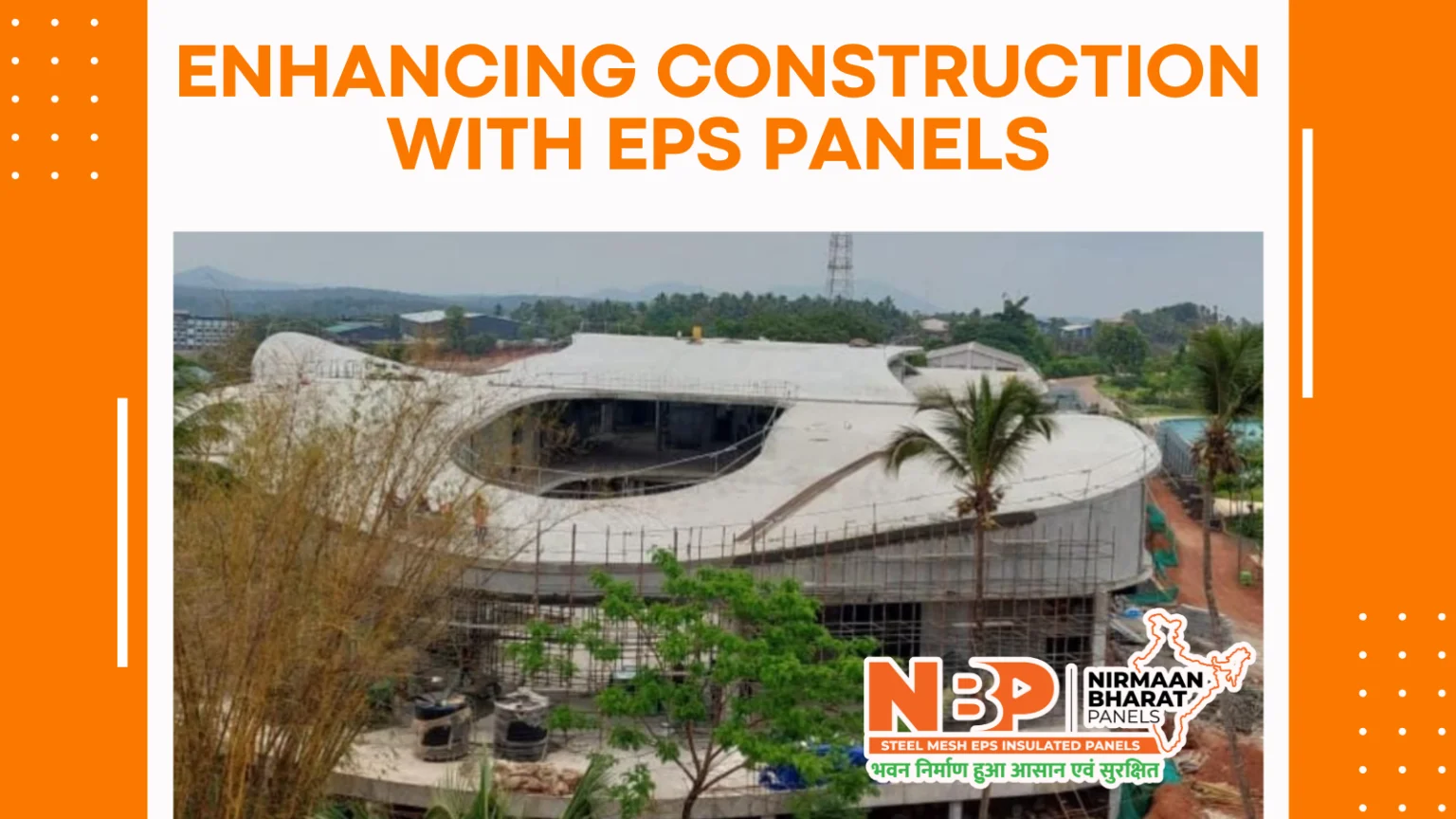Table of Contents
ToggleIntroduction
In the ever-evolving construction industry, the demand for sustainable, durable, and resilient building materials is higher than ever. Expanded Polystyrene (EPS) panels have emerged as a versatile solution that addresses multiple construction challenges. Known for their lightweight properties and excellent insulation capabilities, EPS panels are now being engineered to provide enhanced fire resistance, earthquake resistance, cyclone resistance, and protection against leakage, seepage, and dampness.
Understanding EPS Panels
EPS panels are made from expanded polystyrene foam, which is a lightweight, rigid, and highly insulative material. These panels are typically sandwiched between two layers of durable materials such as cement boards or metal sheets. The core of EPS panels consists of polystyrene beads that expand when heated, creating a closed-cell structure that traps air and provides excellent thermal insulation.
Fire Resistance
Composition and Testing
EPS panels can be treated with various fire-retardant additives during manufacturing. These additives make the material self-extinguishing when the ignition source is removed, significantly reducing fire spread. EPS panels undergo rigorous testing to meet international safety standards such as ASTM E84 or EN 13501-1.
Real-world Application
In practical applications, EPS panels are combined with other fire-resistant materials such as gypsum boards, fire-rated plasters, and intumescent paints to create a composite system that enhances fire safety. This is particularly important in high-rise buildings, commercial complexes, and public infrastructures where fire safety regulations are stringent.

Earthquake Resistance
Structural Integration
EPS panels are often used within a structural framework made of reinforced concrete or steel. This integration helps create a ductile structure that can flex without breaking during an earthquake. The lightweight nature of EPS panels also means less mass is subjected to seismic forces, which helps reduce inertia and potential damage.
Research and Case Studies
Numerous studies have been conducted on the seismic performance of EPS panel-based structures. For example, research by the Earthquake Engineering Research Institute has shown that buildings constructed with EPS panels and reinforced concrete frames can withstand significant seismic events with minimal damage.

Cyclone Resistance
Wind Load Calculations
EPS panels used in cyclone-prone areas are designed to withstand high wind pressures, often up to 200-250 km/h. Wind load calculations are performed during the design phase to ensure that the panels and their connections can resist the forces generated by strong winds and flying debris.
Installation Techniques
Proper installation techniques, including the use of reinforced connections and bracing, are critical. Panels are securely fastened to the main structure with anchors and bolts designed to hold under extreme wind loads. Additionally, the outer skins of EPS panels are often made of impact-resistant materials like fiber-cement boards or metal sheets.

Leakage, Seepage, and Dampness Proof
Advanced Waterproofing Methods
To further enhance waterproofing, EPS panels can be coated with waterproof membranes or treated with water-repellent chemicals. Joints and seams between panels are sealed with high-performance sealants, ensuring a continuous barrier against water ingress.
Field Performance
EPS panels have been successfully used in a variety of environments, from tropical regions with high rainfall to cold climates where moisture protection is critical. Field studies show that buildings with EPS panels have lower incidence of water-related issues such as seepage and dampness compared to traditional construction methods.

Additional Benefits
EPS panels offer a smart and sustainable solution for maintaining comfortable indoor temperatures throughout the year. By keeping homes cool in the summer and warm in the winter, these panels provide energy efficiency, comfort, and a host of other benefits. As the construction industry continues to prioritize sustainability and efficiency, EPS panels are set to become an essential component of modern building practices. Whether you are building a new home or looking to improve an existing structure, EPS panels are a worthwhile investment that can deliver long-term energy savings and comfort.
Thermal Insulation
The primary function of EPS panels is to provide thermal insulation. The closed-cell structure of the EPS foam traps air, which is a poor conductor of heat. This means that heat transfer through the walls is significantly reduced. During the summer, EPS panels prevent outside heat from penetrating the walls, keeping the interior cool. In winter, they retain the warmth generated inside, preventing it from escaping and keeping the interior warm.
The R-value of EPS panels (a measure of thermal resistance) is typically higher than traditional insulation materials, meaning they provide superior thermal insulation. This leads to significant energy savings over the building’s lifespan. EPS panels can achieve R-values ranging from 4 to 4.7 per inch of thickness.
Reflective Coatings
EPS panels can also be enhanced with reflective coatings on their outer layers. These coatings reflect radiant heat away from the building, further improving the panels’ ability to keep interiors cool during hot weather.

Sound Insulation
The dense core of EPS panels helps to absorb sound, making them effective in reducing noise transmission. This is particularly beneficial in urban settings or near highways where noise pollution is a concern.
Moisture Resistance
EPS panels are inherently resistant to moisture, which prevents issues related to dampness, mold, and mildew. This is important for maintaining a healthy indoor environment and ensuring the longevity of the building structure.
Eco-Friendly Attributes for Energy Efficiency
By reducing the amount of heat entering or leaving your home, EPS panels help maintain a stable indoor temperature. This reduces the need for air conditioning in the summer and heating in the winter, leading to significant energy savings. Homeowners can anticipate reduced utility bills and a smaller carbon footprint.
A well-insulated home ensures a more comfortable living environment. With EPS panels, you can enjoy consistent temperatures throughout your home, avoiding the discomfort of hot spots in the summer or cold drafts in the winter. This is particularly beneficial for homes in regions with extreme temperature variations.
EPS is completely recyclable and can be repurposed into new EPS products or used in various other applications. The production process of EPS also has a relatively low environmental impact, with lower carbon emissions and energy use compared to traditional materials like brick or concrete.
Cost-Effectiveness
The lightweight nature of EPS panels means they are easier and quicker to install, reducing labor costs and construction time. Transport costs are also lower since more panels can be shipped at once compared to heavier materials.
Installation and Versatility
EPS panels are lightweight and easy to install, which can significantly reduce construction time and labor costs. They can be used in a variety of applications, including walls, roofs, and floors, making them a versatile choice for new constructions and retrofits alike.
Case Studies and Examples
Residential Homes
In residential applications, EPS panels have been shown to reduce energy consumption by up to 50%. Homes built with EPS panels maintain a comfortable indoor temperature year-round, providing homeowners with a consistent and energy-efficient living environment.
Commercial Buildings
Commercial buildings also benefit from the use of EPS panels. For instance, office buildings and retail spaces constructed with EPS panels enjoy reduced operational costs due to lower energy consumption. Additionally, the improved indoor comfort can enhance productivity and customer satisfaction.
Conclusion
EPS panels are revolutionizing the construction industry by providing a robust, multi-functional solution to some of the most pressing challenges in building design. Their inherent properties of fire resistance, earthquake resistance, cyclone resistance, and waterproofing make them an ideal choice for diverse environments and applications. As building standards shift towards enhanced sustainability and resilience, EPS panels are poised to become a fundamental element of cutting-edge construction practices.


